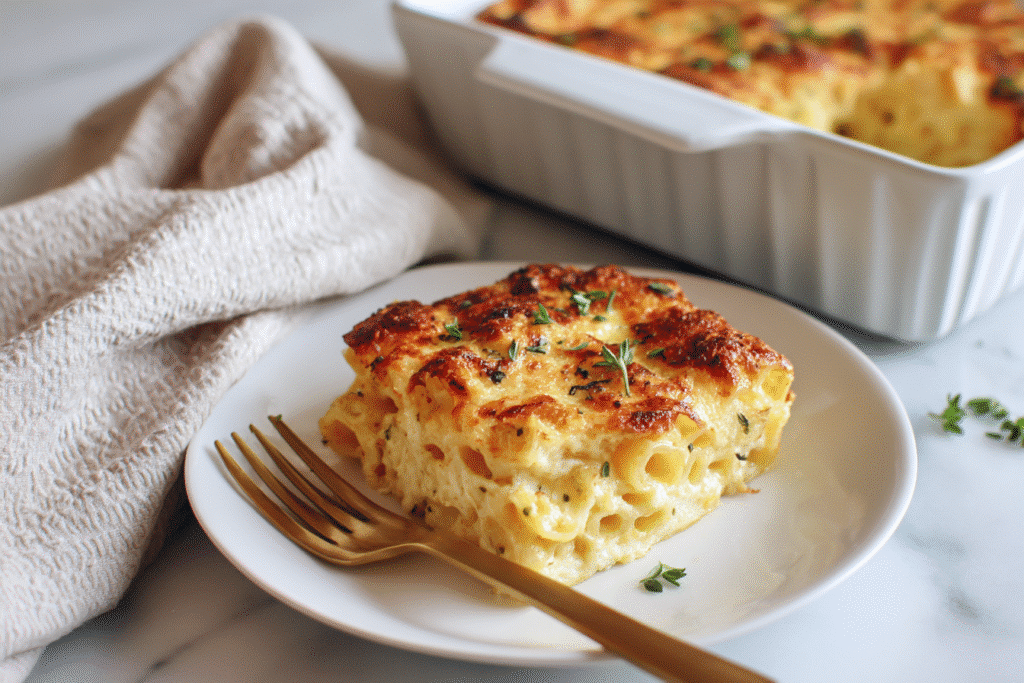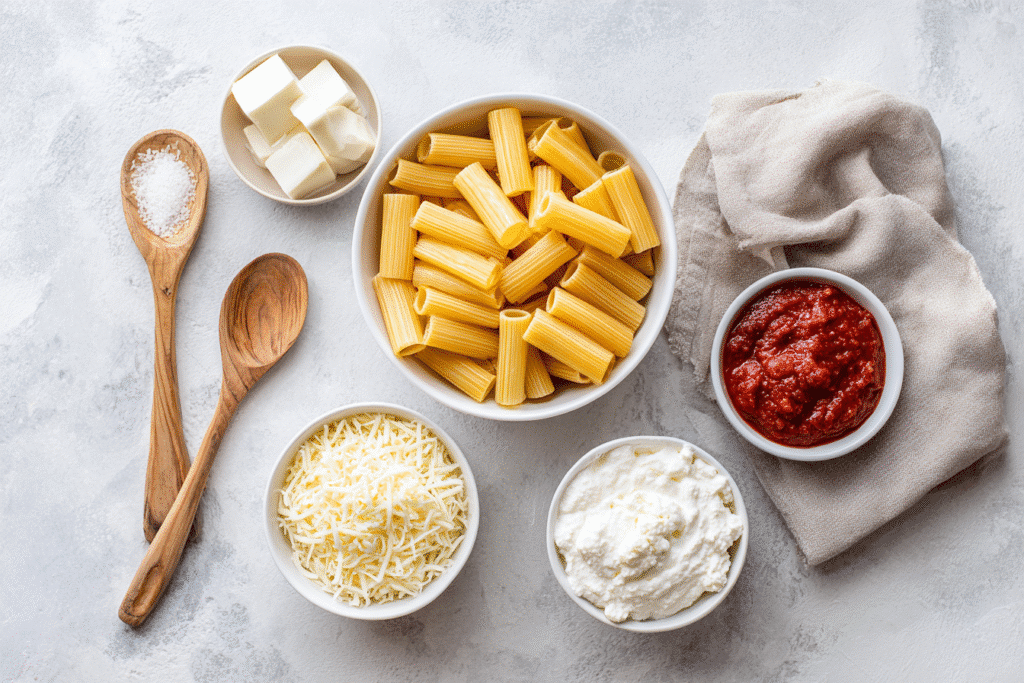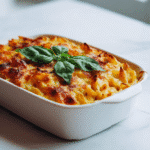
If you’ve ever tried making pasta al forno for one and ended up with enough leftovers to feed a small village… same. Learning how to layer pasta al forno the right way saved me from soggy bottoms, dry tops, and the guilt of tossing half a tray three days later. It’s not just about flavor—it’s about balance, especially when you’re cooking solo.
I’m not Italian, and I didn’t learn this in culinary school—I figured it out the hard way, one overbaked pasta dish at a time. In this post, you’ll get a step-by-step breakdown of how to layer pasta al forno like a proper Italian nonna (without needing a nonna of your own). We’ll cover layer order, portioning tips, and a few solo-cook tricks I’ve picked up making recipes like this pasta al forno with béchamel sauce.
What Is Pasta al Forno?
An oven-baked pasta dish with layers of sauce, cheese, pasta, and optional fillings—comforting, cheesy, and meant to be assembled with intention, not chaos.
Table of Contents
The Nonna Rule: Sauce, Pasta, Repeat — No Shortcuts
So what’s the golden rule? Start with sauce. Always. A base of sauce keeps the pasta from sticking to the pan and drying out. From there, it’s all about structure: pasta, more sauce, filling (if using), cheese. Repeat. Keep each layer thin and balanced—think lasagna, but way more forgiving. And don’t skip the top layer of cheese mixed with just a bit of sauce to help it brown, not burn.
If you’re not into classic red sauces, layering still applies. Even this vegetarian pasta al forno uses the same method—just with a veggie-forward twist. The principles stay the same, whether it’s meat, mushrooms, or mozzarella in the spotlight.
Once you know how to layer pasta al forno properly, your bake goes from “meh” to “why didn’t I make this sooner?” It’s not just about taste—it’s about texture, leftovers you’ll actually want, and a dish that doesn’t fall apart on the plate.
Build Your Layers Like a Roman Ruin
What Goes First in Pasta al Forno?
Here’s the quick answer: sauce always goes first. That first layer of sauce acts like a non-stick barrier and helps the bottom layer of pasta cook through without becoming a crispy mess. Think of it as the insurance policy your solo kitchen didn’t know it needed.
After the sauce? A layer of cooked pasta. Not mushy, not undercooked—al dente is the sweet spot. Then more sauce (light but enough to coat), your filling (if using), and a modest layer of cheese. Repeat until your dish is full but not overflowing. That last top layer? Make it extra cheesy with a final touch of sauce to help it brown without drying out.
Learning how to layer pasta al forno this way changed how I prep baked pasta for myself. It’s not guesswork—it’s a rhythm. Sauce, pasta, sauce, filling, cheese. Repeat. This is how you get those perfect slices with structured layers and melty, bubbly edges.
How Many Layers Is Too Many (Or Not Enough)?
For solo portions, 2 to 3 full layers usually do the trick. Any more, and you risk uneven baking—plus, let’s be honest, no one cooking for one wants to eat the same dish five days in a row. Your layering should match your baking dish. For me, a small square dish or a single-serve ramekin is ideal. You can also split the mixture into two ramekins and refrigerate one for tomorrow.
If you’re short on time but still want that layered magic, try this one-pot pasta al forno. It cheats the layering process a little, but still gives you that baked, saucy payoff—fast.
When you’re figuring out how to layer pasta al forno, keep this in mind: more isn’t always better. A few solid, well-balanced layers beat a towering mess every time.
Easy Pasta al Forno for One (How to Layer It Like a Nonna)

This pasta al forno is baked, saucy, and built just for one—no sad leftovers, no mountain of dirty dishes. Once you understand how to layer pasta al forno the right way, the results are crispy-edged, cheesy, and totally plate-worthy.
Ingredients
- 1 cup cooked rigatoni or penne (al dente)
- ½ cup marinara or tomato basil sauce
- ⅓ cup shredded mozzarella
- 2 tablespoons ricotta (optional)
- 1 tablespoon grated Parmesan
- Pinch of red pepper flakes (optional)
- Salt and black pepper to taste
- Olive oil or nonstick spray (for greasing dish)
Storage Tip: Cook pasta fresh, but assemble two mini portions if you want one to refrigerate for the next day. Just don’t bake both at once.
Optional Swaps:
- No ricotta? Sub with a spoonful of Greek yogurt or leave it out.
- Want a protein boost? Add a few browned sausage crumbles or shredded rotisserie chicken between layers.
- For a low-dairy version, try this pasta al forno with egg instead—it’s creamy without being cheese-heavy.
Step-by-Step Instructions
- Preheat your oven to 375°F (190°C). Lightly grease a small baking dish or oven-safe ramekin.
- Spread a thin layer of sauce at the bottom (this prevents sticking and sets up your base).
- Add a layer of pasta—about half of your cooked portion.
- Spoon on more sauce and dot with half the ricotta and a sprinkle of mozzarella.
- Repeat with another layer: pasta, sauce, cheese. Top with Parmesan.
- Cover loosely with foil and bake for 15 minutes. Remove foil and bake another 5–8 minutes to brown the top.
- Cool slightly before diving in. The layers hold better if you let it sit for 5 minutes (yes, this part’s hard).
Why This Matters
Mastering how to layer pasta al forno properly gives you that golden edge, gooey middle, and zero “pasta soup” moments. It’s the solo meal that tastes slow-cooked—even if you just winged it between Zoom calls.
Pro Tips for Cooking Solo
Cooking for one comes with its own kitchen rules. You’ve got less margin for error, fewer dishes to spare, and zero backup if something flops. But that also means you learn fast—like how how to layer pasta al forno in a way that delivers without overkill. Here’s what I’ve figured out over many one-dish wins (and a few saucy flops):
- Scale your layers: Use a small oven-safe dish or ramekin—too deep and your layers collapse; too shallow and it dries out.
- Don’t over-sauce: It’s tempting, but too much sauce leads to soup, not structure. Use thin layers and build moisture through cheese or ricotta instead.
- Mix pasta types: Got leftover fusilli and penne? Combine them. Just make sure they’re all cooked al dente. It adds texture and uses up those half-empty boxes.
- Build two small bakes instead of one big one: One for now, one for tomorrow. Bake one, wrap the other.
- Freeze the good stuff: If you’re making extra, freeze fully assembled but unbaked. Bake straight from frozen—just add 10–15 minutes to the cook time.
Mistakes to Avoid + How to Fix Them
When you’re learning how to layer pasta al forno, the truth is—everyone messes up something the first time. Here’s a quick-fix table for the most common solo-cook mistakes and how to recover without tossing dinner.
| Mistake | Fix |
|---|---|
| Too much sauce → soggy layers | Drain the pasta well and reduce sauce in the pan before layering. Use less next time. |
| Pasta stuck to the bottom | Always start with a layer of sauce before pasta. Use oil or spray in your dish. |
| Top layer burned | Cover loosely with foil for the first 15 minutes. Uncover only to brown at the end. |
| Cheese turned rubbery | Use full-fat cheese, not pre-shredded blends. Add cheese in layers, not just on top. |
| Layers slide apart | Let it rest 5–10 minutes before serving. Use a spatula, not a spoon, to serve clean cuts. |
You Asked, We Answered
How to cook pasta like the Italians?
Cook it in well-salted water until just al dente—firm to the bite. Italians never overcook it, and they always pair it with sauce that complements (not drowns) the noodles.
How to make pasta like an Italian restaurant?
Use quality ingredients and finish the pasta in the sauce, not separately. Add a splash of pasta water for silky texture, and toss until it clings beautifully.
How do I prevent a soggy pasta al forno?
Start with al dente pasta, don’t overload the sauce, and follow proper layering. Knowing how to layer pasta al forno—sauce first, pasta, then fillings—keeps it structured and satisfying.
What is al forno style?
“Al forno” means “from the oven” in Italian. It usually refers to baked dishes like lasagna, ziti, or vegetarian pasta al forno—all about layered comfort baked until golden.
Why do chefs keep pasta water?
That cloudy, starchy water is magic. It helps emulsify sauces and gives them that rich, clingy texture chefs swear by.

How to Layer Pasta al Forno Like an Italian Nonna
- Prep Time: 5 mins
- Cook Time: 25 mins
- Total Time: 30 mins
- Yield: 1 serving
- Category: Pasta for One
- Method: Baking
- Cuisine: Italian
- Diet: Vegetarian
Description
A solo-friendly pasta al forno that’s cheesy, saucy, and layered just right—with no leftovers and no soggy middle.
Ingredients
1 cup cooked rigatoni or penne (al dente)
½ cup marinara or tomato basil sauce
⅓ cup shredded mozzarella
2 tablespoons ricotta (optional)
1 tablespoon grated Parmesan
Pinch of red pepper flakes (optional)
Salt and black pepper to taste
Olive oil or nonstick spray (for greasing dish)
Instructions
1. Preheat oven to 375°F (190°C). Grease a small dish.
2. Spread a thin layer of sauce on the bottom.
3. Layer half the pasta, then sauce, ricotta, and mozzarella.
4. Repeat layers. Top with Parmesan and more sauce.
5. Cover loosely with foil and bake 15 minutes.
6. Uncover and bake 5–8 more minutes until bubbly.
7. Let it rest 5 minutes before serving.
Notes
- Use ramekins for two smaller portions.
- Freeze before baking if prepping ahead.
- Swap ricotta for Greek yogurt or leave it out.
Final Bite
Look, you don’t need a big family dinner or a passed-down recipe book to make pasta al forno like a boss. Once you learn how to layer pasta al forno properly, it becomes your weeknight power move—crispy corners, gooey cheese, no soggy regrets.
If you try this solo-friendly version (or tweak it to fit your mood), drop a comment or save the recipe for later. Cooking for one doesn’t mean cooking without soul.
P.S. Love solo-sized comfort food? Follow me on Pinterest for one-pan wonders and weeknight wins, or hang with me on X (Twitter) for real-time kitchen rambles and small-batch cravings. Let’s cook for one, together.
